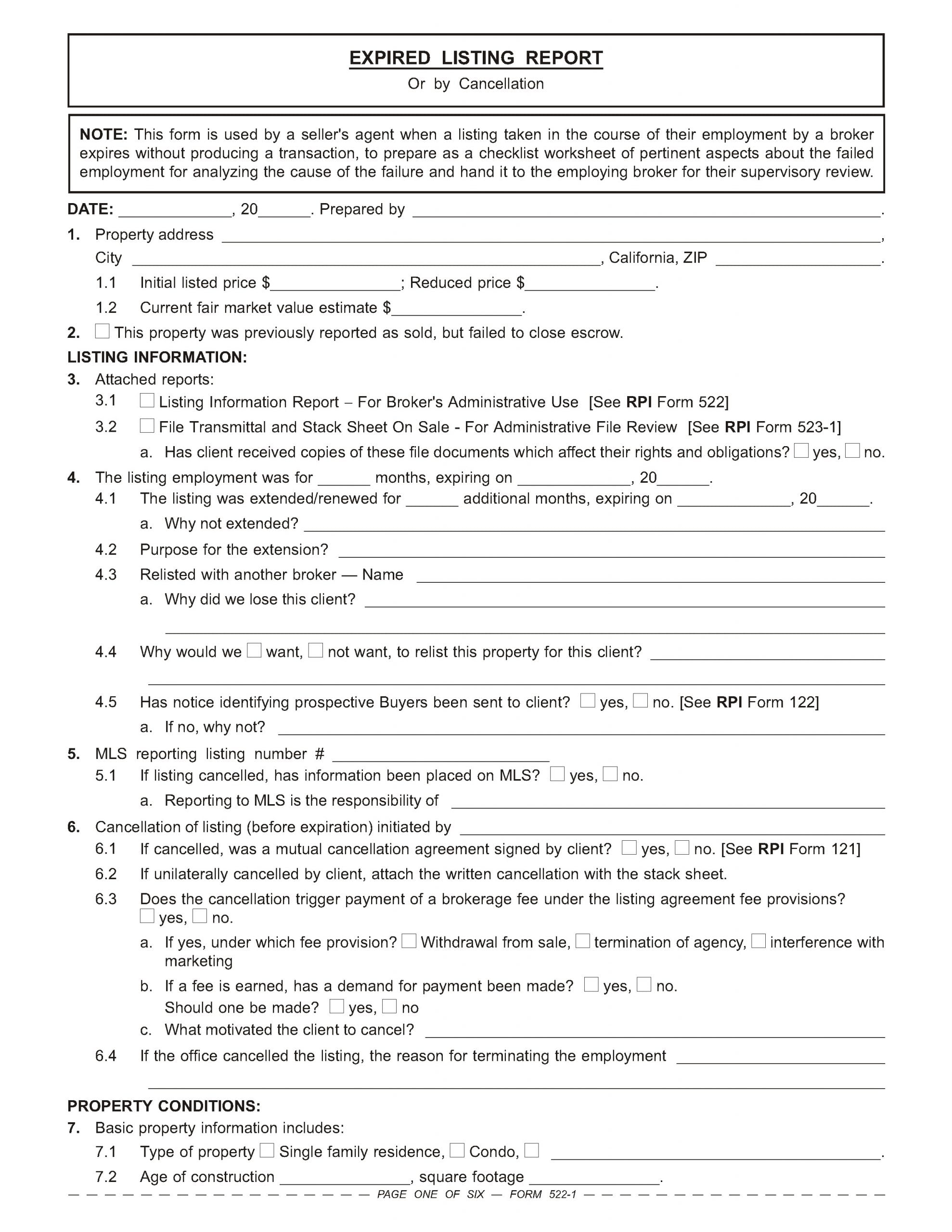Gathering marketing information
Over 80% of all real estate sales transactions are conducted through a sphere of influence — meaning it was premised on an existing relationship which led to a sale, according to a national trade association. Further, 90% of buyers and 70% of sellers report they intend to use their same agent again on future transactions, or refer others to them for real estate services.
Without collecting and harvesting client information, agents and brokers are continuously hunting down new clientele without building repeat business — or business connected to prior clients.
In addition to a broker or agent’s existing marketing campaign — which may consist of multiple categories of leads, such as FARM leads, web leads and niche specialization leads — brokers and agents use forms to document and retain client information. The broker or agent then uses the information collected in the forms to better mine for clients and quickly expand the number of potential fee-generating transactions they are able to close. Harvesting client data known to the agent is undertaken as part of an agent and broker’s forward-looking marketing activities.
Client data is documented at numerous points in a transition, such as:
- when a listing is entered into [See RPI Form 522];
- when a property is sold and the objective of the employment is fulfilled [See RPI Form 523]; and
- when a listing expires without producing a transaction or is cancelled. [See RPI Form 522-1]
Together, the related series of forms contain a wealth of pertinent information which is later used by the broker or agent for marketing purposes, such as:
- how the client found the brokerage [See RPI Form 522 §5];
- the client’s contact information and motivation to sell [See RPI Form 522 §6.3];
- the client’s relocation intentions when selling [See RPI Form 522 §6.4];
- the source of the buyer who purchased the listed property, such as the local MLS, internet or open house [See RPI Form 523 §13];
- the reasons why a client cancels a listing, why it expired without an extension, and the marketing activities conducted to locate a buyer [See RPI Form 522-1 §§4, 6 and 9]; and
- the client’s cooperation and participation in the listing of their property. [See RPI Form 522-1 §§14 and 15]
Continue reading for commentary specific to the use of each form.
A duty to supervise
Although obtaining and later evaluating client activity enhances the broker or agent’s marketing efforts, it is but one reason for tracking transactions through forms. Another reason is to fulfill the employing broker’s supervision requirements.
A broker needs to require their agents to report when:
- a listing is taken;
- an offer is accepted; and
- the sale closes escrow.
However, it’s prudent practice for brokers to have their agents report transaction activity by documentation at every step of the process. Documentation provides primary evidence of the agent’s activities which helps the broker fulfill their duty to supervise. It also gives the broker a paper trail (or digital trail) to refer to when something goes wrong, such as agent negligence or a client pursuing legal action against the broker and sales agent.
Related article:
Tracking the transaction
When a sales agent enters into a listing with a client for the services of their broker’s staff, they need to prepare and submit a checklist type of form to the broker’s transaction coordinator (TC), office manager or the broker themselves.
On the form, the agent notes all relevant information about activities undertaken over the course of the employment. [See RPI Form 522]
The broker reviews these completed forms, directly or through the TC or office manager they have employed. The review needs to be done regularly — once a week or at least once a month depending on the nature of the listing and the size of the broker’s staff.
When escrow is closed on a sales transaction, a property sold report is prepared. The property sold report lists the property’s sales price and the fees paid to the broker, listing agent and any referral fees. It also contains information on trust account funds, service providers and the buyer and seller for structuring future marketing. [See RPI Form 523]
Alternatively, when the property does not sell and the listing expires or is cancelled, the agent files an expired listing report. Here, the agent details the steps taken to sell the property, why the property did not sell and whether the brokerage should consider working with that client in the future. [See RPI Form 522-1]
Using a listing information report
The agent who obtains a property listing becomes the individual in the broker’s office who is initially responsible to the broker for the care and maintenance of the client’s file.
On entering into a listing, the agent sets up a physical client file to house information and documentation on all activity which arises within the broker’s office due to the existence of the employment. [See RPI e-book Office Management and Supervision, Agency, Fair Housing, Trust Funds, Ethics and Risk Management Chapter 3]
The client file contains any paperwork, notes, billings, correspondence, email printouts, fax transmissions, disclosure sheets, worksheets, advertising copy, copies of offers/counteroffers and rejections and all other related documentation. Thus, everything that occurs as a result of the client employment is centrally retained in the client file to be reviewed by the broker.
A seller’s agent uses the Listing Information Report published by RPI (Realty Publications, Inc.) to establish a file for a property listing with all the terms and details needed of a property listing for their broker’s supervisory review. [See RPI Form 522]
The report is used when:
- a new listing agreement for the sale of property is taken; and
- modifications are made to the employment or terms for marketing the property. [See RPI Form 522 §1]
The Listing Information Report documents:
- details on the employment under the listing agreement [See RPI Form 522 §2];
- the brokerage fee to be paid by the seller and how it is to be split between the broker and agent [See RPI Form 522 §3];
- property information [See RPI Form 522 §4];
- the source of the listing lead [See RPI Form 522 §5];
- the client’s information [See RPI Form 522 §6];
- all office activity which arises within the broker’s office due to the existence of the listing [See RPI Form 522 §7];
- any addenda to the listing agreement [See RPI Form 522 §8]; and
- all information provided in the listing package. [See RPI Form 522 §9]
Additional forms and documents used to build a file’s content may vary depending on the type of property and transaction involved. These forms and documents typically include:
- checklists prepared by a broker or their listing coordinator;
- a TC’s closing checklist [See RPI Form 521];
- escrow worksheets [See RPI Form 403];
- work authorization forms [See RPI Form 108 and 130-134];
- advance cost checklists; or
- income property analysis forms. [See RPI’s Income Property Brokerage (IPB) Suite of Forms]
In addition to fulfilling supervisory requirements, the broker uses the Listing Information Report when they mine for clients. Not only will the broker know which marketing techniques were successful and who referred them, they will also have information on the seller, including their contact details, motivation to sell and where they will be relocating to. [See RPI Form 522 §§5 and 6]
All the information contained in these provisions provides ample opportunity for the broker to collect and organize data on their clients. By collecting personal information on their clients, brokers set themselves up for easier routes to consistently communicate with clients and stay in touch.
That way, the client remembers the broker and agent who served them, and will be more likely to refer their family, friends and acquaintances to the brokerage they are familiar with and regularly contacted by with marketing materials meaningful to them — thanks to the broker and agent’s personalized touch.
Related article:
Using a property sold report
An agent uses the Property Sold Report published by RPI as a record when they close a sales transaction. It allows the agent to prepare a summary report of the agent’s activities, information on the principals and third-party service providers involved and fee arrangements made. This information is then submitted to their broker for supervisory review and marketing analysis. [See RPI Form 523]
The Property Sold Report lists the transaction details, including:
- the property’s sales price [See RPI Form 523 §4];
- the fees paid to the broker, their agent and any referral fees [See RPI Form 523 §§5-8];
- any disbursements from the agent’s share of fee [See RPI Form 523 §9];
- multiple listing service (MLS) reporting information [See RPI Form 523 §10];
- the trust funds received and distributed [See RPI Form 523 §11];
- a list of the service providers involved [See RPI Form 523 §12]; and
- information on the buyer and seller for structuring future marketing. [See RPI Form 523 §§13-14]
When the broker creates their marketing plans, they use the information in the Property Sold Report. Since the listed property produced a sale — the very objective of the employment — it provides valuable information concerning which marketing activities are successful and what ultimately attracted the buyer to the listing. It also allows the broker to organize the buyer and seller into demographic categories.
For example, the broker will know the type of property sold, and whether the buyer and seller use the property as owner-occupiers or investors. [See RPI Form 523 §§3.1 through 3.2]
The broker may then add the buyer and seller to an electronic database of prior clients. Here, the broker organizes the client information obtained through the details of the transaction — like the type of properties they have bought or sold or whether they are occupants or investors — into their database used to market materials to those prior clients.
Here, the broker has created a depository of information to optimize their marketing techniques. For example, when the client is an investor, the broker knows to send materials pertaining to investment properties to them. Likewise, when the client bought a single family residence (SFR) and was a first-time homebuyer, the broker schedules a reminder to send an annual congratulatory message. Doing so helps the broker remain in contact and receive future referrals from that client.
Related Video: Referral Fees and Business Development
Click here for more information on this topic.
Using an expired listing report
A seller’s agent uses the Expired Listing Report published by RPI when a listing taken in the course of their employment by a broker expires without producing a transaction. It allows the agent to prepare a checklist worksheet of pertinent aspects about the failed employment for analyzing the cause of the failure and hand it to the employing broker for their supervisory review. [See RPI Form 522-1]
The Expired Listing Report contains:
- the property address and price [See RPI Form 522-1 §1];
- a checklist of reports to attach, such as the Listing Information Report [See RPI Form 522; See RPI Form 522-1 §3];
- details on the expiration of the listing [See RPI Form 522-1 §4];
- MLS reporting information [See RPI Form 522-1 §5];
- details on the cancellation of the listing [See RPI Form 522-1 §6];
- basic property information and conditions [See RPI Form 522-1 §7];
- negative aspects of the property and what could have been done to make the property more acceptable and suitable for buyers [See RPI Form 522-1 §8];
- the direct marketing used to locate buyers, such as yard signs, flyers, online MLS postings, open house events, newspaper and magazine ads and public event distributions [See RPI Form 522-1 §9];
- the indirect marketing activities used to locate buyers, including submission to the local MLS, caravan activity and weekly MLS trade meetings [See RPI Form 522-1 §10];
- whether a marketing or listing package was prepared for prospective buyers and how it was used [See RPI Form 522-1 §11.1];
- a checklist of the contents of the listing package and how the package assisted prospective buyers and seller’s agents [See RPI Form 522-1 §§11.2 through 11.3];
- other promotional activities that may have helped locate a buyer for the property [See RPI Form 522-1 §12];
- whether contract negotiations were conducted with prospective buyers for the property and what happened with them [See RPI Form 522-1 §13];
- the seller’s level of cooperation and participation [See RPI Form 522-1 §14];
- the seller’s involvement or interference in marketing the property [See RPI Form 522-1 §15];
- the seller’s motivation to list and sell the property and what they intend to do with the property since it hasn’t sold [See RPI Form 522-1 §16]; and
- final observations, recommendations and comments from the agent, including their opinion on what caused the listing not to sell. [See RPI Form 522-1 §17]
Using the Expired Listing Report allows agents to document the activities undertaken in listing the property and present the data to their employing broker for use in supervising as required.
The broker then takes the information on the report into account as a detailed record of all facts which relate to the transaction. The record indicates which techniques were implemented and which ones were not, helping brokers identify techniques that did not work to produce a sale and are therefore to be improved or discontinued.
Ultimately, the report helps agents and brokers avoid having clients cancel a listing, or allow a property listing to expire unrenewed without a sale for the same reason that already occurred. Past mistakes are avoided, and the operations of the brokerage are therefore improved.
Further, like the Listing Information Report and Property Sold Report, the Expired Listing Report also provides an opportunity for the broker to collect and harvest pertinent client data for future marketing. [See RPI Form 522; See RPI Form 523; See RPI Form 522-1]
Related article:
Want to learn more about documenting and tracking activities? Click the image below to download the RPI book cited in this article.


















